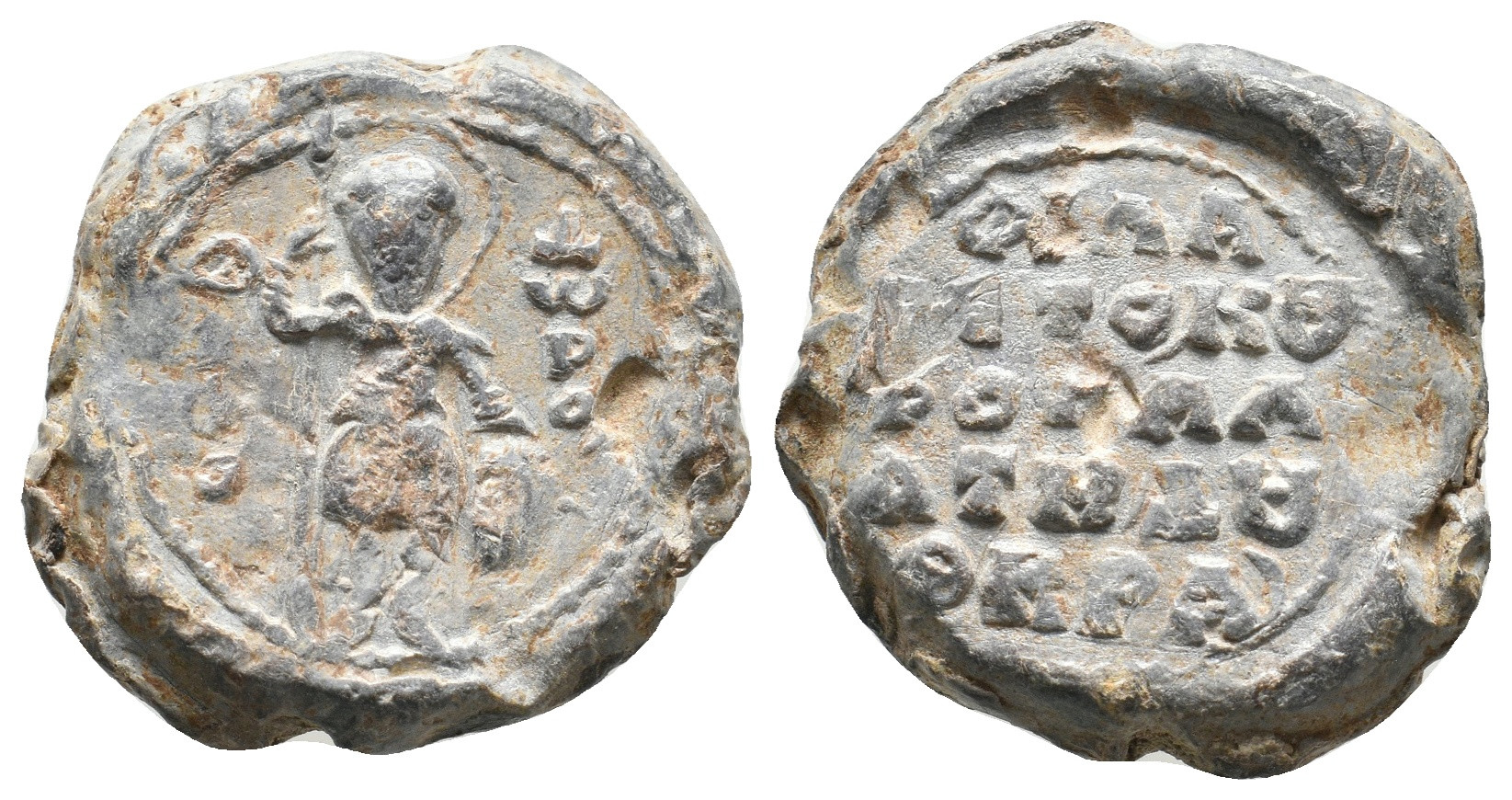Philaretos Brachamios, kouropalates and doux, circa 1080 AD
Identifier
ANRO-1706
Seal Description
Ranks & Titles: kouropalates, doux
Specifications: 23.70mm, 12.46g, 12h
Obv. Description: Saint Theodore, nimbate, standing facing, holding a spear in his right hand and resting his left hand on a shield.
Obv. Inscription: ο / θ / ε / ο-δ / ω / ρ / ο = Ὁ ἅγιος Θεόδωρος ('Saint Theodore'), dotted border.
Rev. Description: Inscription in five lines.
Rev. Inscription: φιλα / ρετο, κου / ροπαλ / ατη, δου / [κα] ορρα = Φιλαρέτῳ κουροπαλάτῃ δούκᾳ, ὁ Βρα(χάμης)
Inscr. Translation: Philaretos Brachamios, kouropalates and doux
Specifications: 23.70mm, 12.46g, 12h
Obv. Description: Saint Theodore, nimbate, standing facing, holding a spear in his right hand and resting his left hand on a shield.
Obv. Inscription: ο / θ / ε / ο-δ / ω / ρ / ο = Ὁ ἅγιος Θεόδωρος ('Saint Theodore'), dotted border.
Rev. Description: Inscription in five lines.
Rev. Inscription: φιλα / ρετο, κου / ροπαλ / ατη, δου / [κα] ορρα = Φιλαρέτῳ κουροπαλάτῃ δούκᾳ, ὁ Βρα(χάμης)
Inscr. Translation: Philaretos Brachamios, kouropalates and doux
Provenance
Bucephalus Numismatic Auction 18 Lot 572
Notes
Philaretos Brachamios was a prominent Byzantine general and warlord of Armenian descent during the late 11th century. After the catastrophic defeat at the Battle of Manzikert in 1071, Philaretos maintained control over a quasi-autonomous realm stretching from Cilicia to Edessa, effectively acting as the last prominent military leader in southeastern Anatolia.
Philaretos held various significant titles throughout his career, including taxiarches, protospatharios, topoteretes, magistros, doux, kouropalates, and eventually megas domestikos, protokouropalates, sebastos, and protosebastos. These titles reflect his progression and importance within the Byzantine military hierarchy.
During the reign of Romanos IV Diogenes, Philaretos commanded forces at Romanopolis and later retreated to the fortress of Germanicia, where he established his rule. By 1078, under the rule of Nikephoros III Botaneiates, Philaretos had become kouropalates and doux of Antioch and Edessa. However, his territories were gradually lost to external powers, including the Seljuks, culminating in his retreat to Germanicia after losing Antioch and Edessa.
Philaretos's legacy continued through his sons, who eventually surrendered Germanicia to the Crusaders in 1098. His influence and actions during this period are documented in various seals and chronicles, such as the Chronicles of Matthew of Edessa.
Philaretos held various significant titles throughout his career, including taxiarches, protospatharios, topoteretes, magistros, doux, kouropalates, and eventually megas domestikos, protokouropalates, sebastos, and protosebastos. These titles reflect his progression and importance within the Byzantine military hierarchy.
During the reign of Romanos IV Diogenes, Philaretos commanded forces at Romanopolis and later retreated to the fortress of Germanicia, where he established his rule. By 1078, under the rule of Nikephoros III Botaneiates, Philaretos had become kouropalates and doux of Antioch and Edessa. However, his territories were gradually lost to external powers, including the Seljuks, culminating in his retreat to Germanicia after losing Antioch and Edessa.
Philaretos's legacy continued through his sons, who eventually surrendered Germanicia to the Crusaders in 1098. His influence and actions during this period are documented in various seals and chronicles, such as the Chronicles of Matthew of Edessa.
Collection
Citation
“Philaretos Brachamios, kouropalates and doux, circa 1080 AD,” Armenian Numismatic Research Organization, accessed January 22, 2025, https://armnumres.org/items/show/1706.


